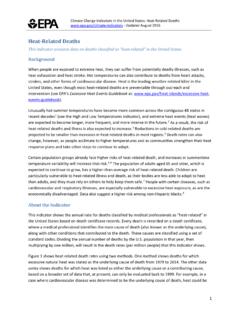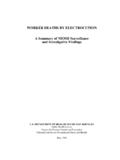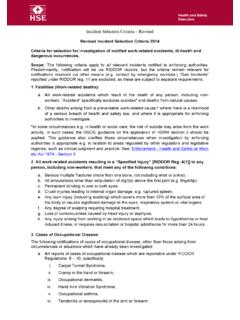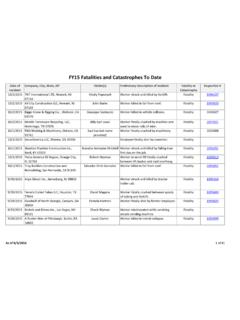Transcription of Fire Losses in Canada Year 2007 and Selected Years
1 0 Fire Losses in Canada year 2007 and Selected Years Mahendra Wijayasinghe, PhD Manager, Research & Analysis Office of the Fire Commissioner Public Safety Division Alberta Municipal Affairs Presented at the CCFM/FC Meeting September 2011, Calgary, Alberta, Canada 1 Abstract Fire incident data for 2007 from BC, AB, MB, ON, NB, and NS; for 2008 from SK; and for 2003 2007 from NT was analysed separately. A total of 42,753 fires resulted in 224 civilian deaths, two firefighter deaths, and $1,551,657,179 in direct property damage.
2 On average, home fires accounted for 30% of all fires and 73% of all fire deaths in the jurisdictions that contributed data. Cooking is the leading cause of home fires and home fire injuries, while smoking materials are the leading cause of home fire deaths. One-third (33%) of all home fire deaths were caused by fires that started in the living room; 20% resulted from fires originating in the bedroom; and 11% were caused by fires starting in the kitchen. Fire causes in Canadian homes were very similar to those reported for homes in the United States.
3 Keywords: Canadian fire statistics, home fires, fire causes. --- Acknowledgements The author thanks all the provincial, territorial and Department of National Defence (DND) contacts listed below who assisted in this study by sharing their fire data, resolving data issues and providing feedback on the analysis output: BC: Dave Ferguson, Deputy Fire Commissioner, Executive Director, Mitigation Emergency Management BC SK: Cheryl Diebert, Deputy Commissioner, Emergency Management and Fire Safety and Sean McKenzie, Business Information Officer, Emergency Management and Fire Safety MB.
4 Paige Dimayuga, Statistician, Labour and Immigration, Office of the Fire Commissioner ON: Alison Wilson, Coordinator, Statistical Services, Office of the Ontario Fire Marshal NB: Stacey Cooling, Fire Reporting Officer, Office of the Fire Marshal NS: Sheila S. Harvey, Fire Services Coordinator, Fire Safety Office of the Fire Marshal NT: Stephen Moss, Fire Marshal QC: Marc Marcotte, Technicien en administration, Service des statistiques & Sylvie Mathurin Chef du Service des statistiques, Minist re de la S curit publique, Direction g n rale de la S curit civile et de la S curit incendie DND.
5 Luc Page, Canadian Forces Fire Marshal 2 Executive Summary The 2002 Annual Report of Fire Losses in Canada , published in 2007 by the Council of Canadian Fire Marshals and Fire Commissioners (CCFM/FC) is the last available analysis of nation-wide fire Losses in Canada . The present analysis was carried out on fire incident data from Canadian provinces, territories and the Department of National Defence (DND) using analytical programs (Statistical Analysis System (SAS) software) developed at the Office of the Alberta Fire Commissioner. Data contributed by BC, AB, MB, ON, NB, and NS for 2007 ; by SK for 2008; by NT for 2003 - 2007 ; and by the DND for 2006 - 2008 was analysed.
6 Data from QC was not complete, and from PE, NL, YK and NU was not available, hence not analysed. An initial assumption of the study was that all Canadian jurisdictions code fire incident data using the Canadian Coding Structure (CCS) accepted in 2002 by the CCFM/FC. However, examination of data structures revealed that none of the contributing jurisdictions fully conform to the CCS. While using the CCS as the base, each jurisdiction has developed their own coding so as to be different from the CCS to varying degrees. A Task Group (National Research Council and the Office of the Ontario Fire Marshal) study (personal correspondence: Mary Prencipe, Fire Protection Engineer, Office of the Ontario Fire Marshal) on National Fire Loss Reporting, presented to the CCFM/FC in 2008, also identified a number of inconsistencies between jurisdictions in definitions of fire, fire death, child, fires with and without dollar loss.
7 In addition, the same study noted variations in the inclusion of fire incident and fire death data from First Nations Communities. The present study did not attempt to address these jurisdictional fire data differences except that the Alberta analytical programs were modified to suit the somewhat unique data structure of each jurisdiction. Accordingly, the data received from each jurisdiction was analysed separately and presented. In addition, fire death data from the contributing jurisdictions (BC, AB, SK, MB, ON, NB, NS and NT), represented by about 75% of the Canadian population, was combined to characterize the causes of fatal fires in Canada and in Canadian homes.
8 Readers are encouraged to access the respective websites of the provincial/territorial fire marshals or fire commissioners to gain an understanding of jurisdictional variations in fire loss data before attempting any inter-provincial comparisons. Key variables used in the analysis were: year , property classification, source of ignition/igniting object, material first ignited, act or omission/possible cause, area of origin, deaths, injuries, and $ Losses . Analysis was not exhaustive but of a preliminary nature and carried out in two stages: First, a top-down analysis of fire data was conducted for each jurisdiction in the following order: 1.
9 Total number of fires, deaths, injuries, and $ Losses . 2. Fires by types of property (structural, vehicle, outdoor). 3. Residential fires. 4. Home fires. 5. Areas of fire origin in homes. 6. Home fire causes. Second, a summary of fire deaths by property classification and fire causes was computed for each jurisdiction. There were a total of 226 fire deaths recorded in BC, AB, SK, MB, ON, NB, NS, and NT. Of these, MB reported two firefighter deaths. Major causes of fatal fires in Canada were: smoking (22%), arson/set fire (9%), electrical (5%), cooking (5%), child fire-play (3%), flammable gas/flammable or combustible liquid ignition (3% each), candles (2%), heating equipment (2%) and exposure (1%).
10 A total of 42,753 fires were recorded in BC, AB, SK, MB, ON, NB, NS, NT. Direct property damage from these fires was estimated at $1,551,657,179. The distribution of fires by property type varied vastly between Canadian jurisdictions (DND not included) and averaged 54% (range 32-78%) structural, 19% (range 8-31%) vehicle and 25% (range 8-52%) outdoor. Corresponding distribution in the US for 2007 was 34%, 17% and 49%, respectively. Fires in residential 3 properties accounted, on average, for 69% of all structural fires and 79% of all structural fire deaths.




